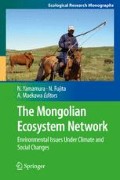Abstract
In Mongolia, agriculture was developed as a new sector under the socialist modernization program. Compared with the traditional small-scale agriculture in western Mongolia, the new form was developed extensively all over the country. The first wave of agricultural projects under the socialist regime was conducted in ecologically appropriate areas. However, the second phase was planned in ecologically unsuitable areas around urban centers, causing deterioration of the grasslands. After the end of the socialist regime, an affirmative policy for agriculture was never implemented, and almost all the agricultural cooperatives failed in retaining their assets. Therefore, many agricultural fields have been abandoned and infested with the weed Artemisia adamsii, which is an undesirable grass species for livestock and a negative allergen for the health of citizens. The author presents the impact of agricultural transformations on nomadic pastoralism in Mongolia, quoting from the narratives of the leaders who drove those programs. Furthermore, an analysis is given of a third wave, characterized as a completely profit-oriented business, which has been initiated since the beginning of 2007.
Access this chapter
Tax calculation will be finalised at checkout
Purchases are for personal use only
Notes
- 1.
In the Orkhon-Selenge River Basin, foxtail millet or wheat was cultivated using a large plough, and in the Gobi Region foxtail millet was cultivated without a plough. In the West Altai Region, barley was cultivated using a small plough, and also in the tributary region of the Zavkhan River wild millet was gathered.
- 2.
It is said to originate from the seventeenth century under the Jungar Khan dynasty. Also, it may have been begun by Turkish Muslims who were moved for agricultural production purposes.
- 3.
More than 80% of the cultivated area is planted with wheat, so only the production of wheat is shown here. Until 1979, the production of wheat was not stable, but from 1980 to 1989 wheat flour was exported.
- 4.
The interview was conducted on 12 August 2008, assisted by Dr. Lkhagvasuren and financially supported by the RHIN project.
References
Academy of Science in Mongolia (1979) Atlas of Ethnography and Linguistics in the Mongolian People’s Republic (in Mongolian and French). Ulaanbaatar, Mongolia
Badamkhatan S (1996) Ethnography of Oirad (in Mongolian). Ulaanbaatar, Mongolia
Bespalov ND (1951) Mongolian Soil (in Russian). Moscow, Russia
Dorj D (1971) East Mongolia in the Neolithic Age (in Russian). Ulaanbaatar, Mongolia
Erdenebaatar B (1996) Socio-Economic Aspects of the Pastoral Movement Patterns of Mongolian Herders. In: Humphrey C, Sneath D (eds) Culture and Environment in Inner Asia, vol. 1.White Horse Publication, Cambridge
Konagaya Y (2010) The History of Agricultural Development in Mongolia: seeking a tradeoff between development and conservation. (in Japanese). Bull Natl Mus Ethnol 35(1):9–138
Lkhagvasuren I, Konagaya Y. (2007) The Twentieth Century in Mongolia (2): Political Life in Socialist Mongolia. Senri Ethnographical Report 72 (in Mongolian). National Museum of Ethnology, Osaka
Perlee K (1959) Mongolian Old Cities in the Ancient and Middle Ages. (in Mongolian). Ulaanbaatar, Mongolia
Potanin GI (1881) Reportage on North-west Mongolia, vol 2 (in Russian). St. Petersburg, Russia
Pozdneev AM (1896–1898) Mongolia and Mongolians, vol 1 (in Russian). St. Petersburg, Russia
Rolomjav B (1976) Form of the Mongolian tradition of cultivation. Study of History 12(8):100–105 (in Mongolian)
Rolomjav B (1983) Transition and Challenges of Development in Mongolian Traditional Cultivation. Study of History 16(6):54–61 (in Mongolian)
Rolomjav B (1984) Soviet Studies on Agricultural Development of Mongolian Peoples’ Republic. Study of History 18(10):76–82 (in Mongolian)
Rolomjav B (1987) Brief history of agriculture in Mongolia (in Mongolian). Ulaanbaatar, Mongolia
Syubin VF (1953) History of cultivation in the Mongolian Peoples’ Republic (in Russian). Moscow, Russia
Author information
Authors and Affiliations
Corresponding author
Editor information
Editors and Affiliations
Rights and permissions
Copyright information
© 2013 Springer Japan
About this chapter
Cite this chapter
Konagaya, Y. (2013). The Impact of Agricultural Development on Nomadic Pastoralism in Mongolia. In: Yamamura, N., Fujita, N., Maekawa, A. (eds) The Mongolian Ecosystem Network. Ecological Research Monographs. Springer, Tokyo. https://doi.org/10.1007/978-4-431-54052-6_19
Download citation
DOI: https://doi.org/10.1007/978-4-431-54052-6_19
Published:
Publisher Name: Springer, Tokyo
Print ISBN: 978-4-431-54051-9
Online ISBN: 978-4-431-54052-6
eBook Packages: Biomedical and Life SciencesBiomedical and Life Sciences (R0)

